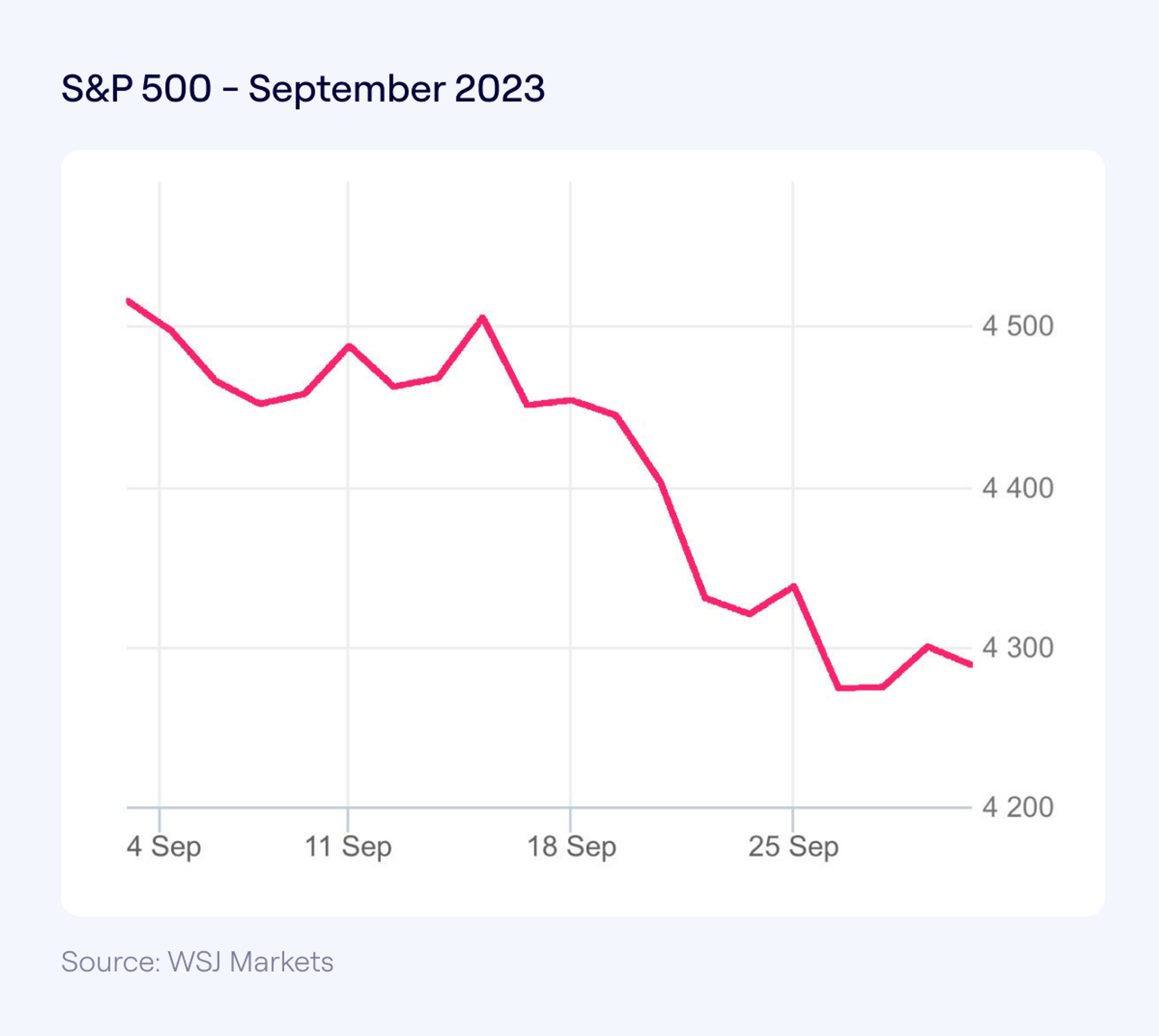6 minutes
Pension performance update: September 2023
- By
- Murray Humphrey
See how Penfold's funds and the global markets performed in September. The UK maintained a stiff upper lip in the face of US turmoil.

While there was a back to school feeling for the UK stock market, which posted gains during September, US shares struggled to get out of summer holiday mode, with the S&P 500 – made up of the 500 biggest companies in the US – falling for the second month in a row.
Periods of market fluctuations like this always happen but keep in mind that many Penfold savers have a very long time for pension savings to accumulate - usually decades, rather than years or months.* They are invested to generate growth in your savings over the long term, but that growth is only possible by having short term ups and downs along the way.
This article is intended to help you understand some of the key reasons why those ups and downs happen. Although there is no guarantee of what will happen in the future, historically, markets have always recovered to grow steadily over the long term. For example between Jan. 1st 2012 and Dec. 31st 2022 the S&P 500 has returned 274.11%, or 12.74% per year.*
* S&P 500 returns between 2012 and 2022.
How our pension plans performed
Although the FTSE 100, which tracks the performance of the 100 biggest companies in the UK, rose in September, the decline of the S&P 500 dented the performance of all our pension plans for the month. The United States is the world’s largest economy and any falls in US stocks always typically outweigh rises elsewhere.

The drop in performance of our pension plans was contained, with our Standard Plan Level 4 dropping 1.55% vs. the S&P 500 dropping 4.87%, demonstrating their resilience during difficult markets.
Penfold's funds are built on strategically diversified portfolios designed to decrease risk exposure, limit potential losses, and improve overall investment performance.
This approach is particularly valuable during challenging market conditions, as a well-diversified portfolio is more likely to withstand market fluctuations and deliver more stable returns over time.
US govt shutdown threat scares investors
It was a month to forget for the US market. The S&P 500 fell for the second time running in September after posting five months of straight gains during March to July.
A political wrangle threatened to trigger a government shutdown, ongoing strikes hampered the film and car industries, and the US central bank disappointed investors by signalling it was open to an additional rate hike to combat stubborn inflation.

The good news is that the US Federal Reserve voted to hold interest rates at an upper limit of 5.5% in September. This was positive as interest rate increases bump up the cost of borrowing for companies, which in turn is usually detrimental for stock markets (and consequently the performance of your pension fund).
The bad news, however, is that Fed chair Jerome Powell surprised investors by suggesting he might hike rates again this year and cut it fewer times in 2024. The Fed has already ratcheted up rates 11 times in the last 18 months, which is the most aggressive series of increases since the early 1980s.
On top of the concerns about what the Fed might do, people have also had to contend with the ongoing threat of a government shutdown, which makes investors jumpy and creates unknowns that they don’t like.
The shutdown stems from a funding dispute between the Democrats and the Republicans, which would have placed tens of thousands of federal employees on furlough without pay and suspended a number of government services.
A deal to keep the government open was struck at the 11th hour but stock markets hate this sort of volatility and the fact it took so long to sort out had already knocked investors’ confidence.
Elsewhere, industrial action by the United Auto Workers union over pay hampered the performance of the shares of the biggest US car companies in the US, with General Motors falling in September and Ford down on where its shares were in July. President Joe Biden even joined workers on the picket line, with the dispute not looking like it will come to an end anytime soon.

While it's helpful to stay informed with the latest news, the S&P 500's upward trend over the past decade demonstrates that, despite short-term market fluctuations influenced by financial events, it's the long-term growth trajectory that is crucial for accumulating pension wealth.
UK bucks trend with healthy gains
The picture was much rosier in the UK, with stock markets seemingly untouched by the turmoil in the US and the FTSE finishing the month higher.

The key to the rise in shares in the UK was interest rates. Like the US, the British central bank opted to hold interest rates steady in September. The difference was this move was unexpected, with the majority of investors believing the Bank of England would choose to increase them.
The decision was immediately positive. Not only do rising interest rates suck money out of the economy but they are particularly bad for companies, such as the country’s biggest house builders, as they result in rising mortgage costs and falling house prices.
The Bank of England’s surprise decision to hold rates was great news for this sector, with Taylor Wimpey, Persimmon and Bellway all posting healthy gains during September.
There were also strong rises for energy giants Shell and BP, and miners Glencore and Rio Tinto, after a North Sea oil field was given the green light for drilling by the UK government.
The controversial Rosebank offshore development off Shetland was granted consent by the regulator, the North Sea Transition Authority, at the end of September. Found 80 miles west of Shetland, Rosebank is Britain's biggest untapped oil field and is estimated to contain up to 300 million barrels of oil.

As the 10 year performance graph of the FTSE 100 above shows, it's the long-term trajectory that truly matters when it comes to building your pension pot. Short-term market changes may occur, but it's the consistent growth over time that contributes significantly to your pension.
EU: some light appears for October
Europe, like the US, had a difficult September. For the second month in a row the pan-European Stoxx 600 index, which tracks the performance of 600 companies across Europe, finished the month lower, with the index declining 2.1% on the back of a 2.8% drop in August.
Retail sales fell in Germany, Europe’s biggest economy, while economic confidence among consumers and businesses within the eurozone fell for the fifth consecutive month in a row, according to the latest data from the European Commission.
Some good news came at the very end of the month, however, with data showing the Eurozone's annual inflation rate slowed to 4.3% year-on-year in September from 5.3% in August.
This is still well above the 2% target set by the European Central Bank but it gives investors hope that the central bank may be in a position to cut rates and inject some life into the economy and the stock market going into October. Fingers crossed.
Check fund performance anytime
If you’re not already using it, there’s so much you can do with the Penfold app. You’ll see your total pot value instantly when you open the app and monitoring the investment performance of your pension takes just one tap more – choose the ‘Your Plan’ option along the bottom of the screen.
The home screen also shows the activity on your pension – just like your bank statement. Plus, you can top up your pension with spare cash anytime just by tapping the ‘add money’ option. Our app puts your pension in your pocket, so it’s there whenever you need it.
* If you’re close to retirement or considering accessing your savings it is important that to think about your current fund performance and consider taking independent financial advice.

Murray Humphrey
Penfold